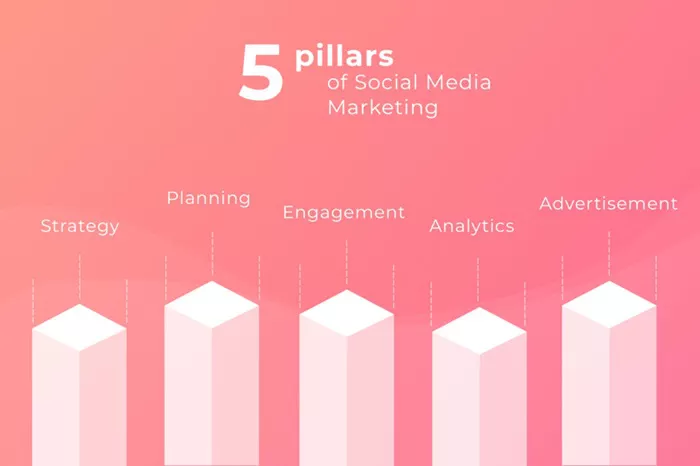Social media marketing has become an essential strategy for businesses looking to enhance their brand presence, engage with their audience, and drive sales. Understanding the foundational elements of social media marketing is crucial for creating effective campaigns. In this article, we will explore the five pillars of social media marketing, providing insights and strategies to help you leverage these components for success.
1. Strategic Planning and Goal Setting
Understanding Your Objectives
The first pillar of social media marketing is strategic planning and goal setting. This foundational step involves defining clear, measurable objectives that align with your overall business goals. Common objectives include increasing brand awareness, driving website traffic, generating leads, and boosting sales.
To set effective goals, utilize the SMART criteria: Specific, Measurable, Achievable, Relevant, and Time-bound. For example, instead of a vague goal like “increase social media presence,” aim for “gain 1,000 new followers on Instagram in the next three months.”
Conducting a Social Media Audit
A comprehensive social media audit is crucial in this phase. Review your current social media activities to identify strengths, weaknesses, opportunities, and threats (SWOT analysis). Analyze metrics such as engagement rates, follower growth, and content performance. This audit will help you understand where you stand and guide you in refining your strategy.
Developing a Social Media Strategy
Based on your goals and audit findings, develop a detailed social media strategy. This strategy should outline your target audience, key messages, content themes, posting schedule, and chosen platforms. Additionally, include a budget allocation for paid promotions and tools.
2. Content Creation and Curation
Crafting High-Quality Content
Content is the heart of social media marketing. Creating high-quality, engaging content that resonates with your audience is essential. This includes a mix of visual content (images, videos, infographics), written content (blogs, captions), and interactive elements (polls, quizzes).
Focus on producing content that adds value to your audience. For instance, educational content, behind-the-scenes looks, and user-generated content often perform well. Ensure your content aligns with your brand voice and maintains consistency across all platforms.
Content Curation Strategies
Content curation involves sharing relevant content from other sources that will interest your audience. This strategy helps keep your social media profiles active and provides additional value to your followers. Curate content from industry leaders, influencers, and reputable sources, and always give proper credit.
Utilizing Content Calendars
A content calendar is a valuable tool for planning and organizing your posts. It helps you maintain a consistent posting schedule, track important dates (e.g., holidays, product launches), and coordinate content across different platforms. Use tools like Google Calendar, Trello, or dedicated social media management software to create and manage your content calendar.
3. Audience Engagement and Community Building
Engaging with Your Followers
Active engagement with your audience is crucial for building relationships and fostering a sense of community. Respond promptly to comments, messages, and mentions. Engaging in meaningful conversations, acknowledging feedback, and showing appreciation for your followers can enhance loyalty and trust.
Building a Community
Beyond individual interactions, focus on building a community around your brand. Create and nurture online communities or groups where your audience can connect with each other and share their experiences. Host events, run contests, and encourage user-generated content to strengthen community ties.
Monitoring and Responding to Feedback
Regularly monitor social media channels for feedback and mentions of your brand. Use social listening tools to track conversations and sentiment about your brand. Address negative feedback professionally and promptly, and leverage positive feedback to highlight success stories and testimonials.
See also: 11 Social Media Marketing Processes
4. Analytics and Performance Measurement
Tracking Key Metrics
Analyzing performance metrics is essential for assessing the effectiveness of your social media efforts. Key metrics to track include engagement rate, reach, impressions, click-through rate (CTR), conversion rate, and return on investment (ROI).
Utilize platform-specific analytics tools (e.g., Facebook Insights, Twitter Analytics) and third-party tools (e.g., Google Analytics, Hootsuite) to gather data. Regularly review these metrics to identify trends, measure progress towards goals, and make data-driven decisions.
Adjusting Strategies Based on Insights
Use the insights gained from analytics to refine and adjust your social media strategy. If certain content types or posting times yield better results, adapt your approach accordingly. Continuously test and optimize your strategies to improve performance and achieve better results.
Reporting and Communication
Prepare regular reports to communicate social media performance to stakeholders. Include key metrics, insights, and recommendations for future actions. Clear and concise reporting helps demonstrate the value of social media efforts and supports decision-making processes.
5. Advertising and Promotion
Developing Paid Social Media Campaigns
Paid social media advertising allows you to reach a broader audience and achieve specific objectives. Platforms like Facebook, Instagram, LinkedIn, and Twitter offer various ad formats, including sponsored posts, carousel ads, video ads, and more. Develop targeted ad campaigns based on demographics, interests, and behaviors to maximize reach and engagement.
Budget Management and Optimization
Effective budget management is crucial for maximizing the impact of your paid campaigns. Allocate your budget based on platform performance, audience targeting, and campaign goals. Monitor ad performance regularly and adjust spending to optimize results.
A/B Testing and Refinement
A/B testing involves comparing different versions of ads to determine which performs better. Test various elements, such as headlines, visuals, and calls to action, to identify what resonates most with your audience. Use the results to refine your advertising strategies and improve overall campaign effectiveness.
Conclusion
Mastering the five pillars of social media marketing—strategic planning and goal setting, content creation and curation, audience engagement and community building, analytics and performance measurement, and advertising and promotion—will position your brand for success in the digital landscape. By understanding and implementing these pillars, you can create a robust social media strategy that drives meaningful results and helps you achieve your business objectives.
Related topics:
- How Much Can You Make In Social Media Marketing
- Why You Need Social Media Marketing: A Comprehensive Guide
- Why Social Media Marketing Is Important

